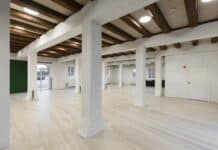By Stanley Quentin Hulin
Published in the January 2006 issue of Today’s Facility Manager

Floors consist of up to five elements: the foundation, thesubfloor, the underlayment, the floor covering, and the wear surface.Although each component contributes to an effective flooring system, itis the covering and the surface that are visible and directly exposedto the effects of soil, dirt, and grit.
Floor coverings are divided into seven major categories based oncommon characteristics and properties. Categories include carpet andsix hard floor covering types—concrete, clay, stone, wood, specialty,and resilient.
Floor Covering Options
Traditionally, concrete floor coverings have been used asfunctional floor surfaces in industrial environments. Recentinnovations in the traditional methods of concrete maintenance,however, have led to increased use in retail, grocery, and other typesof facilities. These innovations range from better, faster dryingaqueous sealers with lower volatile organic compounds (VOCs) todecorative acid stains (increasingly popular in retail) to diamondabrasives, which are relatively new and making headway in the industry.This technology, usually associated with stone maintenance, can deliverharder and denser polished concrete surfaces with higher reflectivity,without the use of sealers.
Floor coverings made from clay materials and fired at hightemperatures have properties suited for different environments. Ceramictile is a sound choice for rest rooms, because it is highly resistantto moisture penetration. Quarry tile and pavers have strongslip-resistant characteristics that make them ideal for kitchen areas.New advances in porcelain make it a suitable selection for high trafficareas such as malls.
The sheer elegance of stone, combined with its durability, makes itwell suited for entryways of commercial “Class A” facilities, hotels,museums, and government buildings. Stone classifications are granite,limestone, serpentine, marble, travertine, quartzite, slate, andsandstone. Each has its own distinct properties, which should beconsidered when selecting natural stone flooring.
Terrazzo and agglomerates, which are 70% or more natural stone(granite or marble usually) embedded in a cementitious or resinousbinder, can be good for use in high traffic areas, such as schools andtransportation facilities.
Wood flooring (solid or engineered) is extremely attractive.However, it is important to keep in mind that wood flooring hasproblems with water and abrasion sensitivity. Wood is a relatively softmaterial compared to other coverings. Installation and maintenancedemand a definite skill set more finely tuned than required for otherflooring.
Specialty floor coverings are composed of products found in othercategories. They are made of special materials and demand specialmaintenance procedures. These floors combat specific situations, and athorough understanding of their purpose is necessary before placement.
Electrostatic Discharge (ESD) flooring, which protects against theeffects of electrostatic damage, is often found in high tech electronicand communications facilities.
Safety flooring usually has texture or an additive to make it moreslip-resistant. Other specialty classifications include raisedflooring, metal, glass, and recycled materials.
The resilient floor covering classifications include, but are notlimited to: linoleum, cork, rubber, sheet vinyl (inlaid, heterogeneous,and homogeneous), solid vinyl, vinyl composition tile (VCT), vinylasbestos tile (VAT), asphalt tile, and polymeric-poured seamless.Resilient flooring is found in almost every environment, includinghealth care, school, and retail. Although each of these classificationsis in the same category, special care is required, as some are waterand/or abrasion sensitive. Damage can occur from improper maintenancemethods. [For more on resilient flooring maintenance, see “Green Solutions,” January 2006.]
Maintenance Assessments
When assessing maintenance needs, there are factors that should beevaluated beyond flooring identification and square footage. Objectivesregarding the overall environment, degree of congestion, and amount ofaccess time are essential in choosing the best program.
Expectations for cleanliness, appearance, and safety impactmaintenance costs. Clearly defining these objectives helps ensure goalsare met.
The environment of the facility or area includes the types of soilsthat will be present, while traffic conditions dictate how soil willmove throughout the building. Understanding the environment helps inselecting cleaning systems and service procedures required. Determiningtraffic conditions helps establish service frequency.
Congestion also plays a major role in the time required to performservice. Physical congestion represents the number of objects that mayimpede performing maintenance and cleaning services if they are notremoved.
Area congestion is a measure of how the area is divided and impactsthe time needed to perform services. For example, a 2,500 square footopen area takes far less time than several offices in the same sizearea.
Personnel congestion is an issue with facilities that are openconstantly. While objects and people can be temporarily relocated, thisincreases potential liability.
Elements that take up small or large blocks of time may restrictwhen or how a job is accomplished. Limited access to a building and theamount of time allowed in it can hamper services. Moving from one placeto another in a large facility is also time consuming.
Although daily and routine maintenance may be performed byjanitorial service companies, it is important to seek hard floormaintenance professionals who specialize in periodic and restorativemaintenance of many floor covering categories. If the technician’sskill level is lacking, there is a good chance of failure and evenliability. The budget should be able to support required maintenanceand cleaning procedures.
Understanding floor covering categories and characteristics, alongwith basic maintenance procedures can help facility managers makebetter flooring selection, installation, and maintenance decisions.
Hulin has been in the hard floor maintenance industry since 1975, providing services, management, and sales/marketing expertise, aswell as maintenance seminars in the U.S. and abroad. He is technical advisor for the Commercial Division of the Institute of Inspection Cleaning and Restoration Certification.

















![[VIDEO] Collect Asset Data at the Speed of Walking a Building](https://facilityexecutive.com/wp-content/uploads/2024/02/maxresdefault-324x160.jpg)